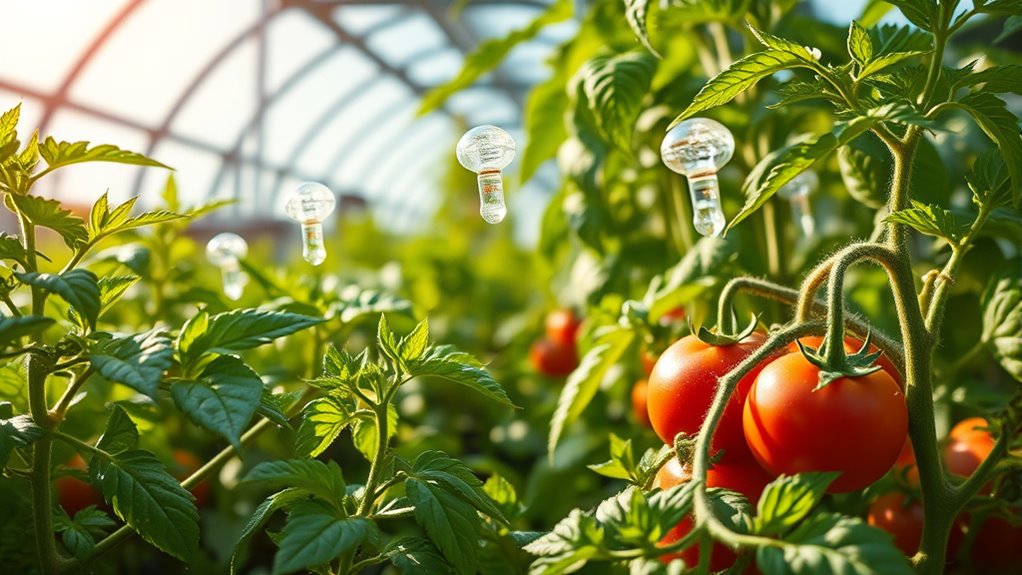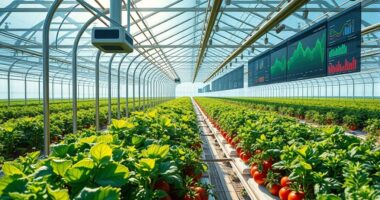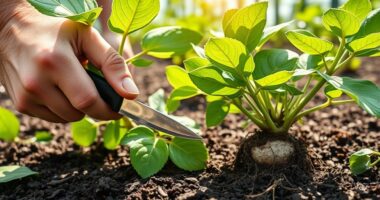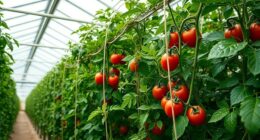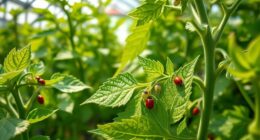Co₂ enrichment involves increasing carbon dioxide levels in your growing space to boost plant growth and crop yields. By maintaining ideal CO₂ levels, usually between 800 and 1,200 ppm, you can enhance photosynthesis, resulting in faster growth, healthier plants, and higher productivity. Proper management with sensors and containment prevents environmental issues. Want to discover how to optimize your setup for maximum results? There’s more to learn about effectively using CO₂ to grow stronger, faster plants.
Key Takeaways
- CO₂ enrichment increases photosynthesis efficiency, leading to faster plant growth and higher crop yields.
- Maintaining optimal CO₂ levels (800-1,200 ppm) maximizes growth without causing stress.
- Proper containment and monitoring prevent CO₂ leaks and ensure consistent, effective enrichment.
- Combining CO₂ enrichment with proper light, nutrients, and humidity enhances overall plant development.
- Responsible management of CO₂ use supports sustainable practices and minimizes environmental impact.
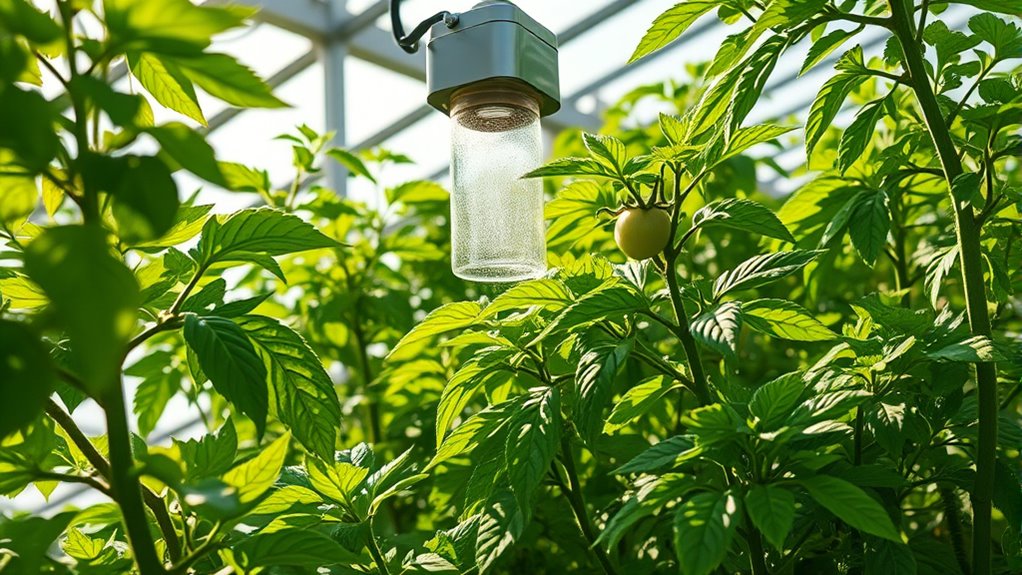
Co₂ enrichment involves increasing carbon dioxide levels in controlled environments to promote plant growth. When you adjust CO₂ concentrations, you’re directly influencing the rate of photosynthesis efficiency, which is the process by which plants convert light into energy. Elevated CO₂ levels can enhance this process, allowing plants to produce more sugars, grow faster, and develop more robust structures. This is especially beneficial in greenhouses or indoor farms, where environmental conditions are carefully managed. By supplying additional CO₂, you create an environment that maximizes plant productivity, leading to higher yields and healthier crops.
CO₂ enrichment boosts photosynthesis, plant growth, and crop yields in controlled environments like greenhouses and indoor farms.
However, you should also consider the greenhouse gas impact of this practice. While enriching CO₂ can boost plant growth, you’re also increasing greenhouse gas levels that could potentially escape into the atmosphere if not properly contained. It’s essential to use systems designed to prevent leaks and minimize environmental impact. When managed responsibly, CO₂ enrichment can be a sustainable way to enhance agricultural output without markedly contributing to greenhouse gas emissions. In fact, some practices involve capturing and recycling CO₂ emissions from industrial processes, which further reduces the overall environmental footprint.
In terms of practical application, you’ll want to monitor CO₂ concentrations carefully. Too little won’t produce the desired effect, but too much could stress plants or cause unwanted side effects like altered transpiration rates. Typically, ideal CO₂ levels in controlled environments range from 800 to 1,200 parts per million, depending on the plant species and specific growing conditions. You might also incorporate sensors and automated systems to regulate CO₂ delivery precisely, ensuring your plants receive the right amount without waste or excess. Additionally, understanding how photosynthesis efficiency can be maximized with proper CO₂ levels is crucial for optimizing growth outcomes.
It’s also worth noting that increased photosynthesis efficiency from CO₂ enrichment can lead to greater biomass accumulation, which is advantageous for commercial growers aiming for faster harvest cycles. Nonetheless, you should keep in mind that the benefits of CO₂ enhancement are most pronounced when other factors—such as light, nutrients, and humidity—are optimized. Otherwise, the potential gains in growth rate might not be fully realized.
Frequently Asked Questions
How Does Co₂ Enrichment Affect Plant Nutrient Uptake?
You might wonder how increased CO₂ levels influence plant nutrient uptake. When CO₂ is enriched, it enhances photosynthesis, leading to improved root development. Stronger roots can absorb nutrients more efficiently, boosting overall nutrient absorption. As a result, your plants grow healthier and stronger because they can access essential nutrients more effectively, supporting better growth and productivity. This process highlights the positive effect of CO₂ enrichment on plant nutrition.
Are There Environmental Risks Associated With High Co₂ Levels?
Imagine the unseen danger lurking as CO₂ levels rise—yes, high concentrations can threaten your environment. You might think it’s just about plants, but it fuels climate change, risking severe ecosystem disruption. These risks aren’t distant—they affect your air quality and future. While CO₂ enrichment helps crops, pushing levels too high may accelerate global warming, making it essential to balance benefits with potential environmental harm. Stay aware, stay safe.
Can Co₂ Enrichment Be Used Outdoors Effectively?
You can use CO₂ enrichment outdoors, but outdoor limitations and weather challenges make it less effective than indoors. Wind disperses CO₂ quickly, and rain or temperature fluctuations can reduce its impact. To succeed, you need controlled environments or specialized equipment to maintain ideal CO₂ levels. Otherwise, environmental factors hinder consistent CO₂ enhancement, making outdoor use complex and less reliable for boosting plant growth compared to indoor methods.
What Are the Cost Implications of Implementing Co₂ Enrichment?
You should consider the economic analysis and installation costs when evaluating co₂ enrichment. Implementing this system involves initial expenses for equipment and setup, which can be significant. Ongoing costs for monitoring and maintaining the system also add up. While benefits include increased crop yields, you need to weigh these against the costs to determine if the investment makes financial sense for your operation.
How Does Co₂ Enrichment Impact Pest and Disease Resistance?
You might notice that co₂ enrichment can enhance pest suppression and improve disease resistance in plants. By increasing carbon dioxide levels, you can promote stronger plant growth, which often results in healthier plants better equipped to fend off pests and diseases. This creates a natural defense, reducing the need for chemical treatments. Ultimately, co₂ enrichment can help you cultivate more resilient crops while potentially lowering pest and disease management costs.
Conclusion
By enriching your plants with CO₂, you can markedly boost their growth—some studies show up to a 30% increase in biomass. Imagine transforming a small garden into a lush, thriving oasis simply by adjusting the carbon dioxide levels around your plants. This technique offers a promising way to enhance crop yields and plant health naturally. So, next time you want healthier, faster-growing plants, consider CO₂ enrichment and watch your garden flourish.
